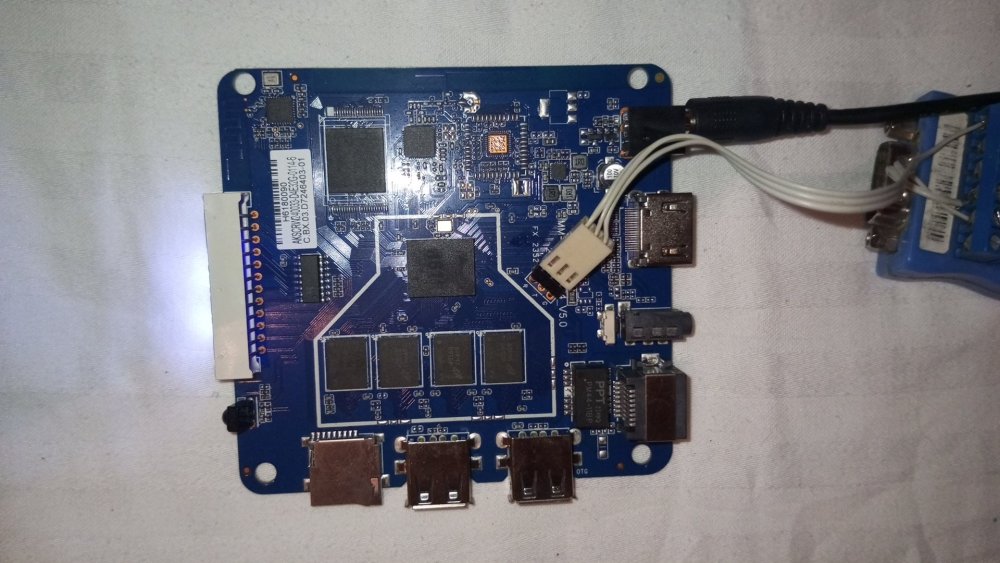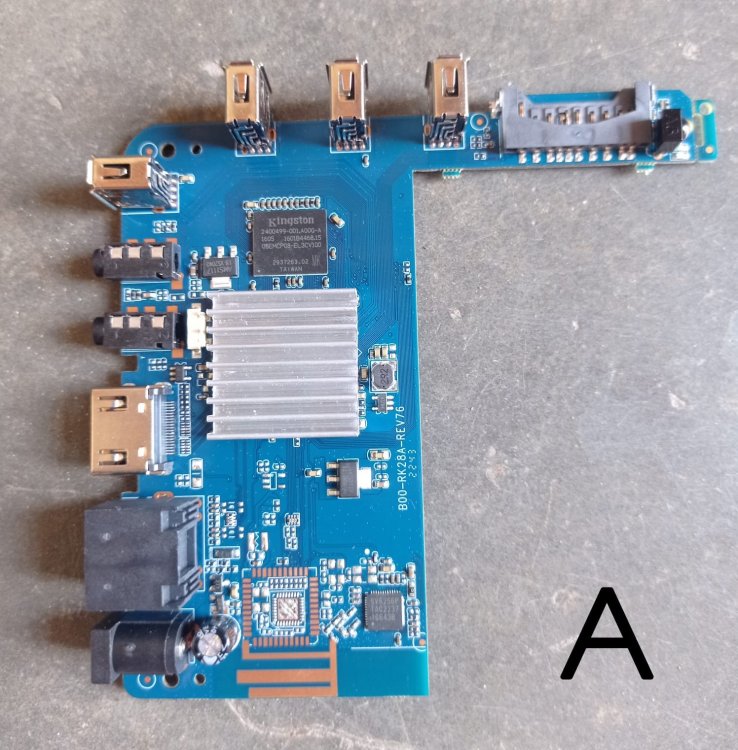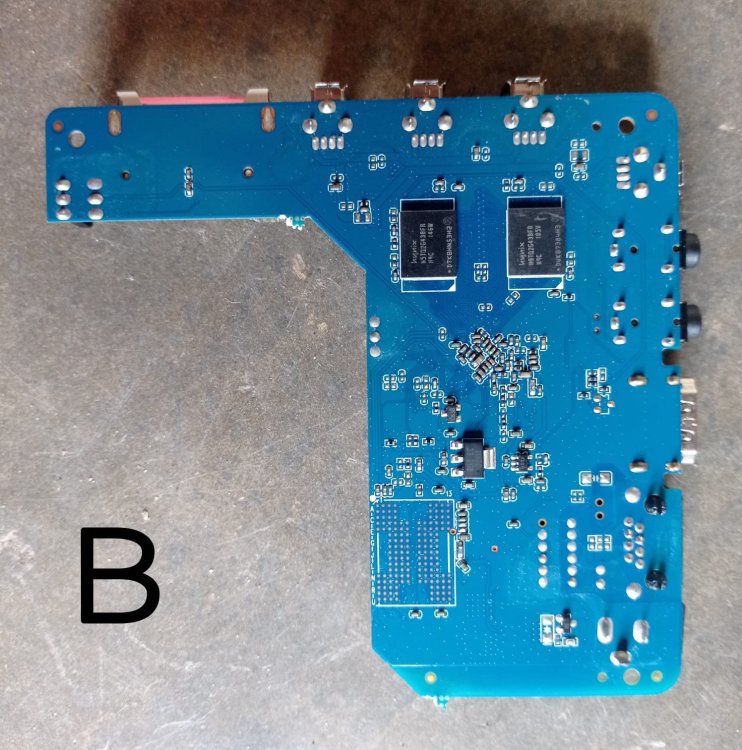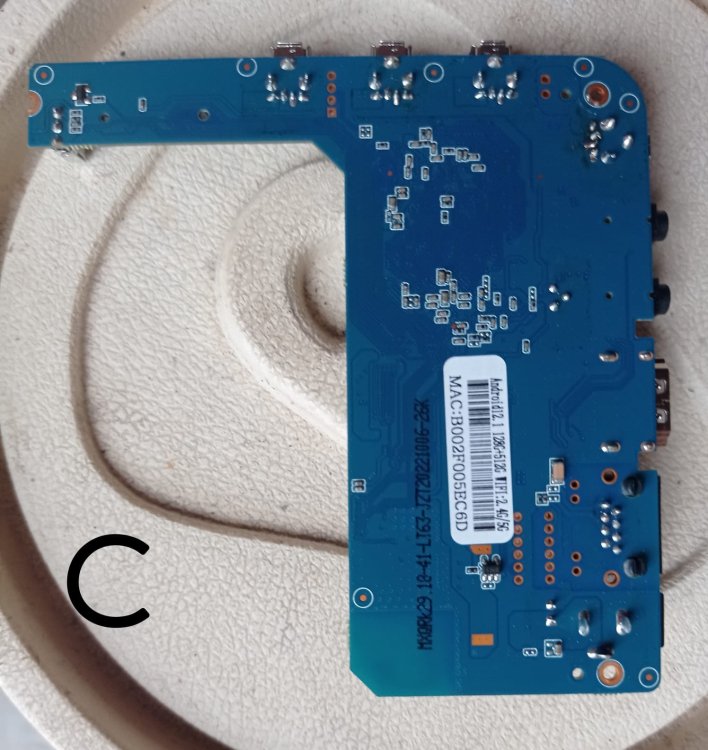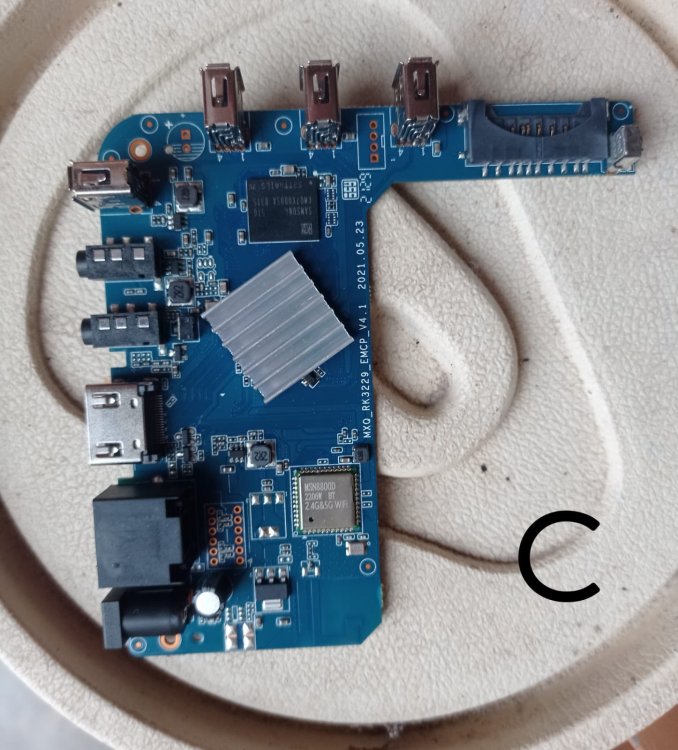All Activity
- Past hour
-
Yes correct the SSV6252p is hard to get it run because no support , the MSN8800D i think was a old chip from i-phone or a clone from something , support looks bad ( only some one match with google ) but its have nothimng to do with emmc support , maybe this board has nand or eMCP memmory and than also emmc not found ( Nand only in legacy image support , eMCP only with correct led-config sometimes) when you have exp in hot air soldering maybe swap the wifi this a best solution or use usb stick
-
- Today
-
Broadcom brcmsmac(PCIe) and brcmfmac(SDIO/USB) drivers https://wireless.docs.kernel.org/en/latest/en/users/drivers/brcm80211.html Broadcom brcmfmac driver Support for both 32 and 64 bit Linux kernels Firmware installation Current For SDIO driver you need to copy the nvram for your system and place it in /lib/firmware/brcm. The nvram file name depends on the chip you have. The kernel log will tell you the exact file name. For the USB driver no nvram file is strictly needed: in fact, the driver only loads the firmware blob and does not look for an nvram text file. However, the nvram parameters are still required and they are already part of the firmware blob. This is a TRX file which contains the nvram parameters as a sequence of zero-terminated plain text strings, appended at the end of the last section. For an example of how to modify/add nvram parameters for USB devices, see this post: https://elimo.io/2-4ghz-coexistence-reverse-engineering-broadcom-chips-to-enable-packet-traffic-arbitration/ The firmware files are located in the linux-firmware repository and can be copied as is to /lib/firmware/brcm. SDIO chip on older kernels (before 3.13) In kernel priors to v3.13 the SDIO driver used generic firmware names. Below are the instruction Use the nvram file installed in your system and copy it to /lib/firmware/brcm/brcmfmac-sdio.txt The firmware can be found in the linux-firmware repository. For 4329: cp brcm/brcmfmac4329.bin /lib/firmware/brcm/brcmfmac-sdio.bin For 4330: cp brcm/brcmfmac4330.bin /lib/firmware/brcm/brcmfmac-sdio.bin Alternatively, when not available the Android version can be used as well: git clone https://android.googlesource.com/platform/hardware/broadcom/wlan firmware files: bcmdhd/firmware/bcm4329/fw_bcm4329.bin bcmdhd/firmware/bcm4330/fw_bcm4330_b2.bin NVRAM from EFI Some new devices are storing the nvram which is needed in addition to the firmware by the driver in an EFI variable and the Windows driver can access it (this file should be optional in the case of PCIe devices). Currently brcmfmac does not support this automatically. First mount the efi vars into sysfs: mount -t efivarfs none /sys/firmware/efi/efivars The content of the nvram is in this file: /sys/firmware/efi/efivars/nvram-74b00bd9-805a-4d61-b51f-43268123d113 Copy this file where brcmfmac expects the nvram, for example: cat /sys/firmware/efi/efivars/nvram-74b00bd9-805a-4d61-b51f-43268123d113 > /lib/firmware/brcm/brcmfmac43241b4-sdio.txt
- Yesterday
-
Hello. I have a z8pro TV box, installed an image from x98 but WiFi sv6256 doesn't work, no sound. Specifications: System: Android TV 12.0 Processor: Alwinner H618 Graphics processor: Mali-G31 RAM: 4GB Built-in storage: 32GB Connectors: HDMI 2.1, USB 2.0, USB 2.0, LAN 100Mbit, S/PDIF, AV, MicroSD Auto frame rate: Yes Network interfaces: Wi-Fi 2.4/5GHz, Bluetooth, LAN 100Mbit Maybe someone has already assembled an arbian assembly for this board? Please share.
-
Hi, I need linux kernel source to compile a custom module. The one I downloaded from kernel.org did not work, got module format error, indicating the kernel is different. i did not have this problem compiling the same module for Armbian lepotato (amlogic) Where do I get the kernel source for my Orangepi Zero 2? Linux orangepizero2 6.12.20-current-sunxi64 #1 SMP Sat Mar 22 19:54:28 UTC 2025 aarch64 GNU/Linux linux-headers-current-sunxi64/bookworm,now 25.2.3 arm64 [installed] Armbian Linux current headers 6.12.20-current-sunxi64 linux-image-current-sunxi64/bookworm,now 25.2.3 arm64 [installed] Armbian Linux current kernel image 6.12.20-current-sunxi64
-
Hi! I'm trying to make it work too! How should I name your DTS file from April 3? And then, after copying it, should I run the armbian-add-overlay command and reboot? Thanks for your help!
-
Hi, Pilinha. I am having the same problem. How did you get to get the keyboard working?
-

Making Armbian more embedded
robertoj replied to Peter Allen's topic in Software, Applications, Userspace
Start with a minimal image: no X11, no desktop sudo systemctl list-units --type=service --all Find those services you don't need, and "sudo systemctl disable <service>" Is buildroot a nice experience like armbian? -
TL:DR Orange Pi Plus 2e USB ports are not working on newer images (LE and Armbian). Full story: Hi. I am Catota and I am new here. I am mainly a windows user with very little experience with linux. My brother recently discovered an old forgotten Orange Pi Plus 2e and gave it to me as I was looking for a media player. It has a functional Armbian 20.02.1 installed in its internal memory, but my brother does not know the passwords for either the normal user or root anymore. I installed the latest Armbian from the SD slot and it booted just fine, but the USB ports (used for keyboard and mouse) do not seem to be working. I installed the latest LE from the SD slot and it booted just fine, but the USB ports do not seem to be working. I booted from internal memory into the old Armbian and all USB ports are working fine (but i lack permissions to upgrade or install anything because I do know any passwords). I installed the oldest Armbian (21.02) and LE (10.04) I could find, but the USB ports do not seem to be working. Does anybody know if there is something very obvious that I am missing? Thanks.
-
I have an IoT project that uses an SPI LCD (480x320), showing 1 full screen application on top of X11, which starts automatically, almost in kiosk mode. Is it worth a lot trying to switch to Wayland? I have 2 roadblocks, which I am trying to drill through: * tkinter app re-write in pyqt * starting from a minimal armbian image, and install the bare minimum to have wayland and start the app Solid advantage: * Future proofing the product I have these preconceived advantages: * less resources needed: my application is fine with an OrangePi Zero 3 with 1 GB RAM, I don't want to upgrade RAM * faster startup (now I need to wait 1 minute from power-on to app ready to use, reducing it to 30 seconds would be nice) I know that I can't expect these advantages, since I use SPI instead of HDMI or DSI: * 30 FPS * No frame tearing But really, my main objective is faster startup: will Wayland help me with that? (without having disadvantageous side effects)
-
Found a handful of working mxq boards in the trash, the unique ones are labed R329Q_v8.1, MXQ_RK3229_EMPC_V4.1 and B00-RK28A-REV76. What are they actually? Almost all of them have an ssv6256p. Can someone confirm me it's actually impossible to use the wifi with this chip? I tried and tried and couldn't get it to work. There's one board with a chip called MSN8800D I would try to get wifi with it but multitool says the emmc storage was not found. Did the chip fry, even though it's a 8Gb/8GB one? If it fried the board shouldn't work at all because the ram would fry too, no? It's Samsung KMQ7X000SA-B315
-
glad i stumbled on this - had the same problem and i spent the weekend reconfiguring my nas and turning off all updates for now. Igor you have done great work over the years and absolutely understand the difficulty. I wish I knew programming and could assist. However the helios4 has had a great run, its def time for an upgrade.
-
I am including the Tanix tx6s and Vontar h618 complete android firmware for wifi/bluetooth. I previously tried using some of the files with no success but found the complete firmware save to a usb drive. I think android is using different file names to what is usually expected to work. hopefully its useful to get Bluetooth working in armbian. Tanix Tx6s Wifi/BT: SP6330-X0 Clock: 26.0 MHz tanix tx6s android firmware also includes fdt (dtb) file Vontar H618 Wifi/BT: HK6334Q Clock: 37.4 MHz Vontar h618 android firmware I no longer have working android to boot into. If someone can copy the android fdt (dtb) file from their vontar h618 box and upload it. i would be very grateful. here is how you can do it , i did this for tanix tx6s get android fdt (dtb) think this is the android path to the file /sys/firmware/fdt
-
@dale murata is armbian firmware, samsung is from vontar android firmware, if you open .hcd with text editor you see text of murata or samsung, I just use that as reference for each file.
-
Try some of these images. https://github.com/armbian/os/releases/tag/25.5.0-trunk.507 And please post here what doesn't work with the download link to the image.
-
Ver 20250505-edge kernel 6.15-rc5 - fix Wifi and eMMC
-
Need more debug info. Try running “sudo dockerd --debug”
-
Alfi ciio, I have a Transpeed 8K 4/64Gb and I also use Nick A builds. Docker is installed and running on the 6.9.12 kernel, and it is installed on the 6.12.11 kernel, but it issues an error when running. Job for docker.service failed because the control process exited with error code. See "systemctl status docker.service" and "journalctl -xeu docker.service" for details.
- Last week
-
The GPU node needs to be enabled. There has been adjustments made to the patching for 6.12.y and above, but I haven't messed with yet. Basically nodes need to be added for sound. As for Bluetooth. I haven't figured out yet why it doesn't work on Armbian. In my personal builds it works fine. I believe there is some patching or service preventing it from loading. But I can't be sure. I've put a lot of time already into the DTS to get this working on both REVS. To much time in my opinion. Anyone is welcome to do a PR and add and enable the bits if they like. Otherwise peps are just gonna have to wait till I get around to it again.
-

Efforts to develop firmware for H96 MAX V56 RK3566 8G/64G
Hqnicolas replied to Hqnicolas's topic in Rockchip CPU Boxes
I think the main way to go is to create a .dtsi that will patch the base "old" board with this new features, +&gmac1 { + phy-mode = "rgmii"; + clock_in_out = "output"; + snps,reset-gpio = <&gpio4 RK_PC2 GPIO_ACTIVE_LOW>; + snps,reset-active-low; + /* Reset time is 20ms, 100ms for rtl8211f */ + snps,reset-delays-us = <0 100000 200000>; + assigned-clocks = <&cru SCLK_GMAC1_RX_TX>, <&cru SCLK_GMAC1>; + assigned-clock-parents = <&cru SCLK_GMAC1_RGMII_SPEED>; + assigned-clock-rates = <0>, <125000000>; + pinctrl-names = "default"; + pinctrl-0 = <&gmac1m1_miim + &gmac1m1_tx_bus2 + &gmac1m1_rx_bus2 + &gmac1m1_rgmii_clk + &gmac1m1_rgmii_bus>; + tx_delay = <0x4b>; + rx_delay = <0x26>; + phy-handle = <&rgmii_phy1>; + status = "okay"; +}; -
@Fajar Muttaqin Can you share your compiled kernel & headers `.debs` In default kernel support for filesystems `cifs` & `nfs` were not included. I compiled with these support as well https://github.com/defencedog/orangepi4A/tree/main/kernels
-
@Nick A It started, but it stopped right at the beginning. In fact, well before than the other image secure boot for H618. U-Boot SPL 2025.01-armbian-2025.01-S6d41-P13d0-H8869-Vfdd1-Bb703-R448a-dirty (Apr 25 2025 - 18:09:15 -0300) DRAM:testing 32-bit width, rank = 2 read calibration failed! testing 32-bit width, rank = 1 DRAM:Store cfg DRAM:1st writing pattern DRAM:detecting column address bits detected 11 columns DRAM:restore cfg DRAM:reconfigure for all active rows DRAM:store cfg DRAM:2nd writing pattern DRAM:detecting row address bits detected 15 rows DRAM:restoring cfg DRAM:end of auto detect dram size MBUS port 0 cfg0 0100000d cfg1 00640080 MBUS port 1 cfg0 06000009 cfg1 01000578 MBUS port 2 cfg0 0200000d cfg1 00600100 MBUS port 3 cfg0 01000009 cfg1 00500064 MBUS port 4 cfg0 20000209 cfg1 1388157c MBUS port 5 cfg0 00640209 cfg1 00200040 MBUS port 6 cfg0 00640209 cfg1 00200040 MBUS port 8 cfg0 01000009 cfg1 00400080 MBUS port 11 cfg0 01000009 cfg1 00640080 MBUS port 14 cfg0 04000009 cfg1 00400100 MBUS port 16 cfg0 2000060d cfg1 09600af0 MBUS port 21 cfg0 0800060d cfg1 02000300 MBUS port 22 cfg0 01000009 cfg1 00640080 MBUS port 25 cfg0 0064000f cfg1 00200040 MBUS port 26 cfg0 20000209 cfg1 1388157c MBUS port 37 cfg0 01000009 cfg1 00400080 MBUS port 38 cfg0 00640209 cfg1 00200040 MBUS port 39 cfg0 20000209 cfg1 1388157c MBUS port 40 cfg0 00640209 cfg1 00200040 2048 MiB Trying to boot from MMC1
-
I have an Orange Pi 5 running Armbian Noble and I need a distribution that supports USB OTG in peripheral mode and supports dcw3_generic kernel module. I've tried to compile one with support, but I keep getting: modprobe: FATAL: Module dwc3_generic not found in directory /lib/modules/6.1.115-vendor-rk35xx I triple checked .config and the appropriate flags are set to Y. I am trying to get the Pi to act as a mouse attached to another machine's USB port. Any help is greatly appreciated.


